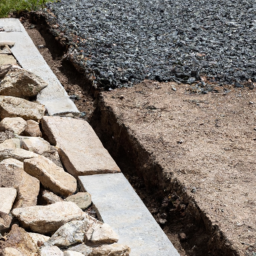How To Lay Rocks Landscaping
How To Lay Rocks For Landscaping
How To Lay Rocks For Landscaping
It's time to finally get that landscaping project rolling and you've decided to go the rock route. Where do you begin? While it might seem like a daunting task, creating a space with rocks that complements your outdoor areas and provides a little extra flair doesn't have to be complicated. Let's get started by understanding the basics of laying rocks for landscaping.
Designing With Rocks
When it comes to landscaping with rocks, the two most important elements are the type of stones you choose, as well as the layout and design of the feature. As far as types, the standard options are river stones, beach rocks, and fieldstone. Deciding which option fits your desired landscape best is a great place to start.
River Stones
River stones are widely available, relatively compact, and easy to work with. This makes them a good choice for DIY projects when you want neat, orderly patterns or small-scale pathways. What's more, they tend to come in various sizes and neutral color ranges, allowing you to coordinate them with the overall landscaping style.
Beach Rocks
Beach rocks are slightly less uniform than river stones and tend to be a bit bigger. Beach rocks make an excellent choice if you're aiming for a more organic or casual look. They can also be used to create murals and faces in rock gardens, vacation cabins, and outdoor seating areas.
Fieldstone
And finally, we come to fieldstone. This type of rock is most often used as accents, rather than the focal point of a landscaping project. That's because of its larger and chunkier shape. Fieldstone is great for creating natural-looking staircases, borders, and planters.
Selecting Your Rocks
Once you've narrowed down the type of rocks you'd like to work with, it's time to start selecting the actual rocks. It's important to keep in mind the size and color of the rocks as you're shopping, since these elements will be critical when it comes to designing the area for your project.
Size Matters
Remember that depending on the type of design you're aiming for, a range of different sizes may be required. When selecting the rocks, look out for ones that fall within the desired range but still feature a bit of variation. This will ensure that you have some leeway down the line.
Blending Colors
The right rocks should blend together harmoniously and create a unified flow. It's essential that you study the shades of the rocks and decide if they coordinate well before committing to your plan. Most stores should have helpful staff, so don't be afraid to take advantage of this resource.
Figuring Out Where To Put Them
The final stage is all about deciding where to place the rocks in your space. To start, you should survey the area as objectively as you can, to ensure that the structural elements of the project will fit together. Take into account the walls, paths, levels, and any other crucial elements that ensure the necessary flow and structure.
Creating Focal Points
Your next step is to create focal points. This can be achieved by employing varied sizes and adding additional elements such as water features, trees, and plants. The goal is to make the arrangement cohesive and attractive, so be sure to take your time and experiment with different configurations.
Utilizing Rocks Creatively
Finally, before getting to the physical labor of laying rocks down, it's worth experimenting with some shapes and patterns. Don't be afraid to put in some creativity, as a creative way to arrange the rocks can add a whole new depth to the space.
In Summary
Whether you're tacking a rock project yourself or you've hired a professional, having a good plan is key to getting the desired results. Taking the time to properly select the right type and size of rocks, as well as the right design, will ensure that you're able to create a dazzling landscape with rocks that will stand the test of time.

Previous Page
Next Page
